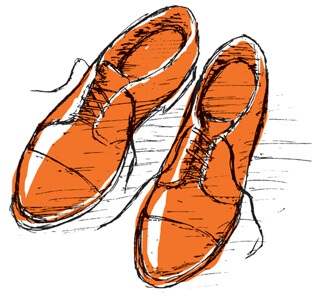In This Shoe, I Thee Wed
My fiancée and I were sitting in our living room one stuffy evening not too long ago, talking about her wedding dress. Out of some combination of tradition, laziness, and superstition, I’ve chosen not to see it before the wedding. Still, I’ve heard all about shopping for it, trying it on, and getting it fitted. I may not know how it looks, but I’ve had dreams about it. I guess we talk about it a lot, actually (but not too much! Hi, honey!).
One day, she said to me, “You know, I’m getting all this stuff for the wedding—a dress, shoes, flowers—but you’re not getting anything. Do you want to get something? Shoes, maybe?”
Now, dear reader, I’m something of a gentleman of distinction. I already own a vintage Oscar De La Renta tuxedo (which I had tailored). I bought it a few years ago when it looked like attending galas might be a regular part of my job, a guess that turned out to be pretty far off the mark (I have worn it once). I also already have some shoes—simple glossy black cap toes from a German manufacturer I’d never heard of before—which I’d planned on wearing. But the shoes, which I got from European discount website Yoox, turned out to be a lot crappier than I thought $100 dress shoes would be: the sole was falling apart by literally the second wearing. Maybe my fiancée was right; I could probably do with some nice shoes. Plus, this seemed like permission to spend a huge amount of money on myself. I may not have taken a lot of convincing.
I decided to get a classic dress shoe, a black cap toe Oxford. It might even be what pops into your head when you picture “men’s dress shoe”: pretty plain shoe, with one seam running over the toe and another mildly sexy curved seam underneath the laces.
One challenge of shopping for a more expensive black Oxford is that a $60 shoe and a $600 shoe are almost indistinguishable when you look at them in the store or online. The real difference is in the materials and the construction, and will be obvious as soon as you start walking around. But how to tell before then?
The easiest way, it occurred to me, was to be involved in the entire process from the start by having a pair custom made. I realized this might be expensive, but I really had no idea how expensive. Maybe $1,000? I decided to investigate.
I found Brooklyn Bespoke, a small custom shoe business run out of a tidy Williamsburg studio by Jesse Moore and Marika Verploegh Chassé. I visited them one recent sweltering afternoon. The shop is more for appointments than walk-ins, so they seemed a little surprised to see me, each working silently on a different project while This American Life played in the background. After some hellos, they unbuttoned their denim smocks, turned down the radio, and started to tell me about their work.
They explained to me that you might not realize it, but your shoes are probably full of trash. If you were to tear apart most mid-priced dress shoes, you’d find that its insole, aka the part your foot actually sits on top of, is made out of “some mixture of leather shavings, dust, and glue,” according to Moore. “Like, chipboard, but leather.” And really, that’s only at the high end. At the low end, you’re probably walking on resin-soaked fabric, or even paper.
Moore and Chassé’s shoes are all leather, every element. This makes them “almost infinitely” repairable; Moore speaks with disdain of shoes that last a mere decade.
This quality doesn’t come cheap. Shoes at Brooklyn Bespoke start at $3,000 and go up from there, depending on the materials and embellishments you want.
I was crushed. This was firmly out of my price range. Still, I asked them to give me some tips on what to look for in other upscale shoes. What makes something worth its price? They both sighed and looked off into the distance.
“It requires a lot of experience to be able to touch it and tell anything,” said Moore. “You can certainly go into the Doc Martin shop, and feel what that feels like: plasticy and rubbery. I’d suggest it’s not really high-quality leather. The truth is that you really get what you pay for when it comes to shoes.”
One thing they said I could look at was construction: stitching vs gluing. Another important thing is welting: that’s the crimpy black stuff that’s furthest down and furthest out that you’d see looking at a dress shoe from above. It basically holds everything together. The top-of-the-line here is Goodyear welting, invented by the tire Goodyears in 1869.
After their pep talk, I felt ashamed to leave without buying something, ashamed to retreat to the world of trash-filled, ill-fitting shoes. But that’s all I can afford. Maybe that’s where I belong.
I took the G to the E to what I thought was the next best thing: that row of shoe stores and upscale department stores along Madison Avenue from roughly 40th to 60th street. I felt poor and cheap and like I was making bad decisions, exactly how I didn’t want to feel at the start of this process.
 My first stop was Berluti, a Parisian shoemaker established in 1895. Its Manhattan store was packed with at least half a dozen staff, all in suits and ties, which were continually popping out from behind corners and seeming surprised to see me. Shoes like I wanted were $1,300, and seemed . . . fine? I turned them over in my hands, hoping to spot some obvious sign of quality. Moore was right, I couldn’t tell. What made this worth $1,300? The staff was swirling. Could they help me, they asked in a way that seemed both a request and a command to not waste their time. I felt hot, I ran away.
My first stop was Berluti, a Parisian shoemaker established in 1895. Its Manhattan store was packed with at least half a dozen staff, all in suits and ties, which were continually popping out from behind corners and seeming surprised to see me. Shoes like I wanted were $1,300, and seemed . . . fine? I turned them over in my hands, hoping to spot some obvious sign of quality. Moore was right, I couldn’t tell. What made this worth $1,300? The staff was swirling. Could they help me, they asked in a way that seemed both a request and a command to not waste their time. I felt hot, I ran away.
I walked down the block to that aggressively fragrant Target for millionaires, Barney’s. Up several escalators to the fifth floor and around a corner, you’ll find men’s shoes. It’s full of garish sneakers for European assholes with more money than taste by designers like Christian Louboutin and Alexander McQueen, but also plenty of what I’m looking for. I did a slow circle, quickly learning that a high price didn’t equal style. Crockett & Jones make unremarkable shoes for which they want $700. Alden: too squat and look like they’re made to be worn with light khakis to a job managing something in a strip mall, $665. Barbanera: half-finished Zara castoffs, $640. Prada long ago left normal people behind, and now mostly makes giant platform shoes for the fashionable children of Korean billionaires, but they offer a cap toe that essentially looks like it came from Wal-Mart and costs $995.
I was a fan of some sensuously light and vaguely avian Ferragamo Studio cap toes. These are the lowest-end shoe Ferragamo makes, and are glued and not welted. Barney’s didn’t have any of Ferragamo’s Tramezza range, widely considered to be some of the most well-made shoes available. The Tramezza run $1,000 to $1,500; the Studio was $595. As it happens, I have this exact same shoe in brown; I’d got it at Beacon’s Closet for $80. Given all of this, I just couldn’t bear to buy them, though they were my favorites so far.
My last stop was Allen Edmonds. After the cool marble halls of Barney’s, it seemed decidedly down market. Louis Prima was blaring from the speakers, as too many customers stood on dirty beige carpet in too small a space. The man behind the counter was wearing a tank top. What was I even doing here?
Still, I had a look at the Park Avenue, Allen Edmonds’ most famous shoe. As their website proudly tells you, it was “the Inauguration Day footwear choice for Presidents Reagan, H.W. Bush, Clinton and G.W. Bush” (Obama reportedly wore—shudder —Cole Haans). These shoes are a bargain at $395. But what are you getting for that money?
The shop actually has a video of their production process, and a display shoe that’s cut in half allowing you to see its components. The insole isn’t dust or cardboard; it’s cork, which the factory heats until it’s a paste, and then spreads on top of the sole. There is a layer of fabric between the upper and the inside of the shoe, which the salespeople told me was to “wick away moisture,” though I’d guess it’s a cost-saving measure of some kind. What’s more, for $125, Edmonds will essentially reconstruct the shoe, replacing the sole, the welting, and even the cork. It’s also Goodyear welted.
Can it be, I thought, that a $400 shoe—cheaper than the most cheaply-made Ferragamos—is really the best shoe for the money?
Well, I’ll find out at my wedding. I bought them. I was careful to tell my fiancée about all the other prices—starting at $3,000 and working my way down—before I told her I’d bought $400 shoes. Still, I wasn’t sure how she’d react.
“Oh, gosh!” she said. “That seems great. Do you love them?” I do. I’ll find out if they were worth it in ten years or so.
You might also like 



















